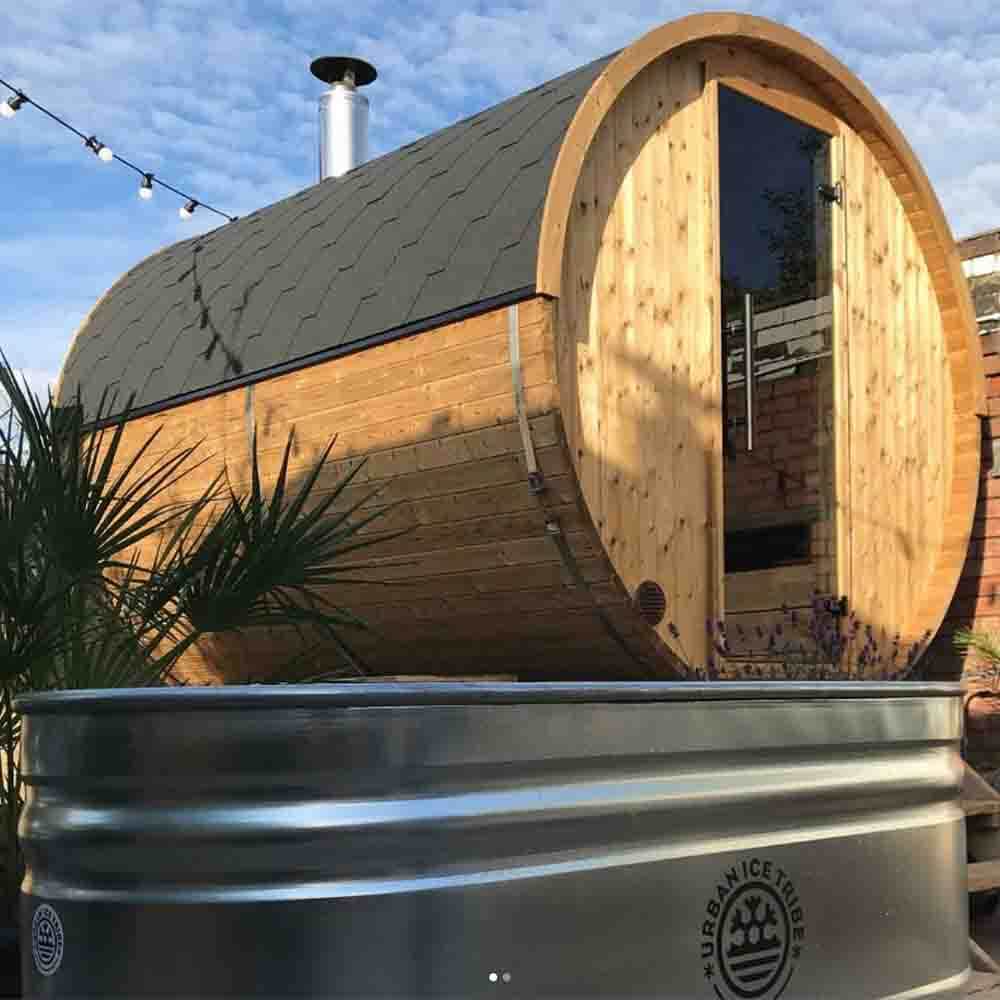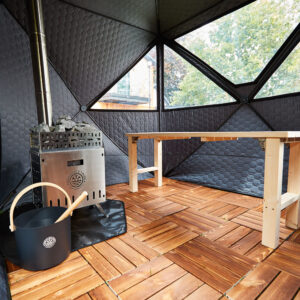
Ice Baths: A Key to Enhanced Recovery and Vitality for Athletes
Explore how ice baths can boost recovery and enhance vitality for athletes. Discover practical tips and insights to elevate your performance. Read more!
Christmas Delivery: UK orders by 10am, 19th Dec. Ireland/EU by 12pm, 15th Dec. Dispatch resumes 2nd Jan.
Spend Over £500 To Get Free UK Delivery - Excludes Certain Postcodes & Round Ice Baths
Delivery to Ireland now available

Using a sauna 4-7 times per week can reduce your risk of cardiovascular disease by up to 70% compared to once-weekly use, according to groundbreaking Finnish research spanning over two decades. But determining how often you should use a sauna depends on your experience level, health goals, and individual tolerance to heat exposure.
The confusion around optimal sauna frequency is understandable. While some wellness enthusiasts swear by daily sessions, others worry about overuse. The truth lies somewhere in between, supported by robust scientific evidence that reveals the ideal frequency varies based on what you’re trying to achieve.
The ideal frequency for sauna sessions depends heavily on your specific objectives. Research shows that different health benefits emerge at various usage levels, making it essential to align your routine with your goals.
General wellness: Start with 1-2 times per week with 15-20 minute sessions. This frequency provides basic health benefits including improved circulation, stress relief, and enhanced sleep quality. Even once weekly use, when consistent, offers measurable improvements in overall well being.
Cardiovascular health: Aim for 3-4 times per week for maximum benefits. The landmark Finnish study published in JAMA Internal Medicine found that participants using saunas 4-7 times weekly experienced a 40-70% reduced risk of fatal coronary events compared to those using saunas once per week. The cardiovascular system responds particularly well to regular heat exposure, with effects similar to moderate aerobic exercise.

Athletic recovery: Daily sessions of 10-15 minutes post-workout optimise muscle recovery and reduce muscle soreness. The enhanced blood flow from frequent sauna bathing helps clear metabolic waste products and delivers nutrients to recovering tissues. Athletes often benefit from this regular protocol when combined with proper hydration.
Stress relief: Focus on 2-3 times weekly sessions emphasizing relaxation rather than intensity. Research in Psychosomatic Medicine demonstrates that regular sauna use reduces cortisol levels and activates the parasympathetic nervous system, promoting deeper relaxation and better sleep.
Weight management: Use the sauna 3-5 times per week combined with proper diet and exercise. While saunas don’t directly burn significant calories, the cardiovascular workout from heat exposure can boost metabolic rate temporarily and support overall fitness goals.
Detoxification: Schedule 2-4 times weekly with adequate hydration. Though the liver and kidneys handle most detoxification, research shows that sweating does eliminate small amounts of heavy metals and certain toxins through the skin.
Daily sauna use is perfectly safe when done correctly, provided you follow essential safety protocols. The key lies in understanding that frequency matters less than proper technique and body awareness.
Limit daily sessions to 15-20 minutes maximum for traditional saunas operating at 70-100°C (158-212°F). For infrared saunas, which operate at lower temperatures of 40-65°C (104-149°F), sessions can extend to 20-30 minutes due to the gentler heat exposure.
Maintain proper hydration before, during, and after sessions. Dehydration represents the primary risk with frequent sauna use. Drink water before entering the sauna room, and consume 16-24 ounces immediately afterward to replace fluids lost through sweating.
Take rest days if you feel fatigued or dehydrated. While daily use is generally safe, your body will signal when it needs recovery. Persistent tiredness, headaches, or irritability may indicate you need to reduce frequency temporarily.
Monitor your body’s response and adjust accordingly. Pay attention to how you feel during and after each sauna session. Signs like dizziness, nausea, or excessive fatigue warrant immediate cessation and evaluation of your routine.
Start with shorter sessions and gradually build tolerance. Even experienced sauna users should begin conservatively when transitioning to daily use, allowing their cardiovascular system and thermoregulatory mechanisms to adapt.
Progressive adaptation ensures safe and effective sauna use while minimizing the risk of heat-related complications. Your experience level determines both session frequency and duration.
Start with 1 session per week for 8-10 minutes in your first sauna session. Position yourself on lower benches where temperatures are milder, typically 10-15°C cooler than upper levels. This conservative approach allows your body to develop heat tolerance gradually.
Increase to 2 sessions per week in weeks 3-4 once you’re comfortable with the initial protocol. Focus on proper breathing and hydration rather than enduring maximum heat exposure. Many beginners make the mistake of pushing too hard initially.
Allow 2-3 days recovery between sessions initially. Your cardiovascular system needs time to adapt to the stress of heat exposure. This recovery period prevents overexertion and reduces the risk of dehydration.
Use a sauna 2-3 times per week for 12-18 minutes once you’ve established base tolerance. You can now handle upper bench positions and higher temperatures comfortably. Your body has developed improved heat shock protein production and cardiovascular adaptation.
Introduce sauna infusions from the second session onward – the traditional practice of pouring water on sauna rocks to create brief humidity spikes. This adds intensity while maintaining safety when done properly.
Practice proper cooling techniques between sessions if doing multiple rounds. A cold shower or brief fresh air exposure helps regulate body temperature and enhances the overall sauna experience.
Expert sauna bathers can safely use saunas 4-7 times per week for 15-20 minutes comfortably. At this level, your thermoregulatory system has fully adapted to regular heat exposure, allowing for optimal benefit extraction.
Incorporate multiple sessions per visit (up to 3 rounds) with cooling periods between each. This traditional Finnish approach maximises cardiovascular benefits while maintaining safety through proper temperature regulation.
Master hot-cold therapy cycles for enhanced benefits. Alternating between the hot room and cold exposure (cold showers, ice baths, or outdoor air) amplifies cardiovascular adaptations and anti-inflammatory effects.

Regular sauna sessions deliver measurable health improvements across multiple physiological systems. The frequency of use directly correlates with the magnitude of these benefits.
Cardiovascular improvements emerge most dramatically with 3+ sessions per week. The heat exposure creates a cardiovascular workout equivalent to moderate exercise, improving heart rate variability, reducing blood pressure, and enhancing vascular function. High blood pressure patients often see significant improvements with consistent use.
Enhanced immune system function develops through regular heat exposure. Frequent sauna use increases white blood cell production and heat shock protein synthesis, leading to fewer sick days and reduced incidence of respiratory infections.
Improved sleep quality and stress reduction result from the parasympathetic nervous system activation that occurs during and after sauna sessions. Evening sauna use particularly benefits sleep onset and depth through the natural drop in body temperature post-session.
Better circulation and muscle recovery occur through vasodilation and increased blood flow. This enhanced circulation delivers nutrients to tissues while removing metabolic waste products, supporting faster recovery from exercise and reducing chronic pain.
Detoxification support happens through increased sweating, though this represents a minor pathway compared to liver and kidney function. Research does show measurable excretion of certain heavy metals and chemicals through sweat.
Potential longevity benefits emerge from consistent, frequent use. The same Finnish studies showing cardiovascular benefits also demonstrated reduced rates of dementia and Alzheimer’s disease among frequent sauna users, suggesting neuroprotective effects.
Multiple variables determine your ideal sauna frequency, making personalised approaches more effective than one-size-fits-all recommendations.
Age and overall health status significantly impact tolerance and safety. Elderly users and those with cardiovascular disease should start with lower frequencies and shorter sessions, ideally with healthcare provider guidance. Young, healthy individuals typically tolerate higher frequencies more easily.
Fitness level and heat tolerance affect adaptation speed. More physically active people generally acclimate faster to regular sauna use and can safely increase frequency sooner than sedentary individuals.
Specific health goals and conditions should guide frequency selection. Someone seeking cardiovascular benefits requires different protocols than someone using saunas primarily for stress relief or muscle recovery.
Time availability and lifestyle factors matter practically. Consistency trumps frequency – regular twice-weekly use provides better benefits than sporadic daily use followed by week-long breaks.
Type of sauna being used influences optimal frequency. Traditional saunas with higher temperatures typically require longer recovery periods between sessions, while infrared saunas allow for more frequent use due to lower ambient temperatures and different heating mechanisms.
Season and climate considerations affect tolerance and safety. Hot summer weather may necessitate reduced frequency or shorter sessions to prevent heat stress, while winter use often feels more comfortable and sustainable.
Recognising when to decrease your sauna use prevents overexertion and maintains the positive effects you’ve gained. Your body provides clear signals when current frequency exceeds optimal levels.
Signs of overuse include persistent fatigue that doesn’t improve with rest, frequent headaches, irritability, sleep disruption, and difficulty tolerating normal daily activities. These symptoms often indicate that your recovery capacity can’t keep up with heat stress.
During illness or when feeling unwell, reduce or eliminate sauna use temporarily. Fever, infection, or inflammatory conditions already stress your cardiovascular system, making additional heat exposure potentially dangerous.
Sleep disruption from evening sessions suggests timing or frequency adjustment. While many people benefit from evening sauna use, some experience overstimulation that interferes with sleep quality.
Medication or health condition changes may require protocol modifications. New blood pressure medications, diuretics, or changes in chronic conditions should prompt reassessment of your sauna routine, ideally with healthcare provider input.
During pregnancy or major life stressors, conservative approaches prove safest. Pregnancy, particularly the first trimester, and periods of high life stress both increase physiological demands that may not accommodate frequent sauna use.
Skin irritation or heat rash development indicates excessive frequency or session length. These conditions typically resolve with reduced use and proper post-sauna hygiene.

Safe sauna use requires understanding both universal precautions and individual risk factors that may contraindicate frequent use.
Medical conditions requiring caution include unstable cardiovascular disease, uncontrolled high blood pressure, severe respiratory conditions, and pregnancy. Low blood pressure can also pose risks through excessive vasodilation during heat exposure.
Hydration importance cannot be overstated with frequent sauna use. Drink water before, during when possible, and after every session. Avoid using saunas on an empty stomach or while dehydrated from alcohol consumption.
Signs to stop sessions immediately include chest pain, severe dizziness, nausea, confusion, rapid or irregular heartbeat, or feeling faint. These symptoms may indicate heat exhaustion or cardiovascular stress requiring immediate cooling and medical attention.
Healthcare provider consultation becomes essential for anyone with chronic medical conditions, those taking medications affecting blood pressure or thermoregulation, and individuals over 65 beginning regular sauna use.
Proper cooling techniques prevent abrupt cardiovascular changes. Gradual cool-down through fresh air exposure before cold showers reduces the shock to your system and enhances safety.
Alcohol and medication interactions pose serious risks. Alcohol impairs judgment and increases dehydration risk, while certain medications (diuretics, antihypertensives, anticholinergics) can amplify heat-related side effects.
Optimising your sauna routine involves more than just frequency – it requires integrating sessions strategically with other wellness practices and maintaining consistency over time.
Consistent weekly schedules produce better results than erratic use patterns. Spreading sessions throughout the week rather than clustering them allows for better adaptation and recovery between exposures.
Combining with other wellness practices amplifies benefits. Post-workout sauna sessions enhance muscle recovery, while meditation or breathing exercises during sessions maximize stress relief. Cold exposure following sauna use creates powerful cardiovascular adaptations.
Timing sessions around daily activities affects both safety and benefits. Morning sessions can boost alertness and circulation for the day ahead, while evening use promotes relaxation and better sleep when timed appropriately.
Seasonal adjustments help maintain year-round routines. Increase frequency during colder months for immune support and seasonal affective disorder prevention, while reducing intensity during hot summer periods to prevent heat stress.
Progress tracking enables optimisation over time. Monitor sleep quality, stress levels, exercise recovery, and cardiovascular markers like resting heart rate and blood pressure to assess your routine’s effectiveness.
Creating sustainable long-term habits ensures continued benefits. Start conservatively, progress gradually, and adjust based on life circumstances rather than rigidly adhering to protocols that don’t fit your lifestyle.

Can I use a sauna every day safely? Yes, daily sauna use is generally safe for healthy adults when sessions are limited to 15-20 minutes with proper hydration. Start gradually and listen to your body’s signals.
How long should I wait between sauna sessions? Allow at least several hours between sessions on the same day. For daily use, this spacing is sufficient, though most protocols recommend at least one complete rest day weekly.
What’s the minimum frequency to see health benefits? Some benefits appear with just one weekly session, but more pronounced cardiovascular and wellness benefits typically require 3+ sessions per week based on research data.
Should I take breaks from regular sauna use? Occasional breaks after illness or during periods of high stress can be beneficial. Many users find cyclical approaches (using regularly for several weeks, then taking a week off) sustainable long-term.
How does sauna frequency compare to exercise frequency? While sauna provides cardiovascular benefits, it doesn’t replace exercise. Think of frequent sauna use as complementary to, not a substitute for, regular physical activity.
Can children use saunas and how often? Children can use saunas with supervision, but should have shorter sessions (5-10 minutes), lower temperatures, and less frequent use (1-2 times weekly maximum) due to their different thermoregulatory systems.
Does sauna type affect recommended frequency? Yes. Infrared saunas operate at lower temperatures and can generally be used more frequently than traditional saunas. Some people tolerate daily infrared use better than daily traditional sauna use.
What time of day is best for frequent sauna use? This depends on your goals and sleep patterns. Morning sessions can energise, while evening sessions promote relaxation. Avoid late evening sessions if they interfere with sleep quality.
Regular sauna use offers remarkable health benefits when approached systematically and safely. Whether you’re seeking cardiovascular improvements, stress relief, or enhanced recovery, the key lies in finding your optimal frequency through gradual progression and careful attention to your body’s responses.
Start with 1-2 sessions per week, gradually increasing as your tolerance develops. Remember that consistency matters more than intensity – regular moderate use trumps sporadic extreme sessions. Most importantly, stay hydrated, listen to your body, and don’t hesitate to adjust your routine based on how you feel.
The path to maximising sauna benefits is highly individual, but the science is clear: regular, properly executed sauna sessions can significantly enhance your health and well-being for years to come.

Founder of Urban Ice Tribe

Explore how ice baths can boost recovery and enhance vitality for athletes. Discover practical tips and insights to elevate your performance. Read more!

There’s nothing quite like the raw, elemental power of a pop-up sauna. Portable, authentic, and deeply restorative, it’s the perfect way to reconnect with nature and yourself. But to take your sauna ritual to the next level, the right sauna accessories can make all the difference.

Transform your outdoor space into a personal wellness retreat with the Urban Ice Tribe Sauna Tent. This detailed setup guide walks you through every step, from unboxing to your first steam session, blending practical instruction with the mindful ritual of heat therapy.
Helping men & women release anxieties & limiting beliefs to experience a life of freedom using powerful breathwork, cold water therapy, movement & sound healing.

No spam, notifications only about new products, updates, offers and announcements.